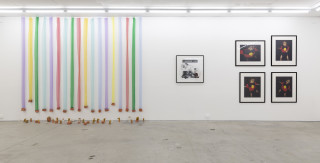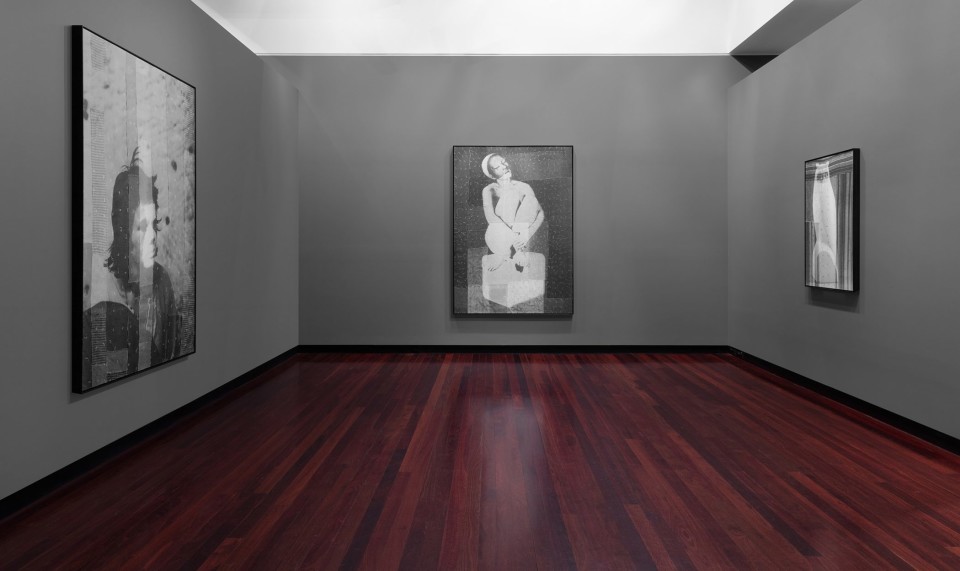Stagecraft represents a homecoming for Ballarat-born and raised artist David Noonan, curated by Julie McLaren.
Exhibition Dates: 20 March 2020 – 31 January 2021
Noonan’s last solo exhibition in his hometown was in 1987 – in his apartment in a distinctive blue-and-white Flemish Baroque style building in Sturt Street, Ballarat’s main thoroughfare. Curiously, given Noonan’s subsequent practice, this nineteenth century building was originally ‘erected solely for the purposes of photography’ as the shop and studio of local photographic firm Richards & Co. [1] Noonan’s 1987 exhibition was titled Industry and Arcadia and featured paintings from his second year of study at the University of Ballarat Arts Academy. [2]
In the intervening 30 years, Noonan has exhibited across the globe and is represented in public and private collections throughout Australia and internationally. He now lives in London and although he still feels a strong connection to his hometown, he associates the history, architecture and weather of Ballarat with a feeling of melancholy. This feeling manifests itself in Noonan’s work in the form of ambiguous theatrical figures engaged in introverted or solitary actions, allowing him to explore concepts of transgression and transformation.
Figures undergoing the process of altering their appearance through costume, masks and the application of makeup echoes Noonan’s own experience of growing up in Ballarat. His interest in punk and new wave as a teenager piqued his interest in sub-cultures which challenge traditional notions of gender and sexuality. Noonan and his circle of friends did not conform to the status quo of the masculine culture prominent in Ballarat in the 1970s and 1980s. Instead they invented their own theatrical worlds which involved dressing up and creating elaborate fictional scenarios as an imagined escape from their parochial surroundings.
The title Stagecraft is a reflection on both the transformative possibilities of space and the transformation of figures within it. The process of ‘stagecraft’ refers to the skill involved when arranging theatrical scenery, lighting, set design and costume. This craft has synergies with the creative process used by an artist in the development of an exhibition – Noonan’s role as an artist is to manipulate an existing space to create a desired effect. In this instance, the artist has used three rooms to represent three distinct aspects of his recent practice, each resulting in different material outcomes – silkscreen on linen collage, tapestry and film.
The works in Stagecraft are the endpoint of a methodical process involving the selection of images which are then ‘collapsed into a unified and resonating image’. [3] Noonan’s collages are created from images drawn from his personal archive of books, magazines, catalogues and other print material which cover a diverse range of topics including theatre, craft and art history. Noonan’s paper collages are comparable to a painter’s preparatory sketch or sculptor’s maquette – the original collage becomes obsolete once they have been translated into the new artform of tapestry or screen-print.
Noonan’s work in the form of ambiguous theatrical figures engaged in introverted or solitary actions, allowing him to explore concepts of transgression and transformation.
Large-scale immersive jacquard tapestries have been made in collaboration with weavers in Flanders, Belgium and Magnolia Editions in Oakland, California who work directly with the artist to translate his collaged imagery into a digital format that a 19th century mechanical loom can translate. The life-size scale of the dramatis personae, or characters, depicted in Noonan’s tapestries results in an intimate bodily relationship between the viewer and the figures within the textiles.
Imagined scenes are not anchored to one particular epoch, but instead exist in the liminal space between one moment and the next, allowing Noonan to transcend time and create new narrative possibilities. He is resistant to overtly unpacking the context of these narratives, and instead the viewer is invited to construct their own meanings based on personal knowledge and experience. He likens this experience to listening to a song – the works resonate an atmosphere which triggers memory and emotion, resulting in personal and unique readings by each individual.
Mask 2015 is a large-scale silkscreen on dyed linen collage depicting an ambiguous figure wearing a mask on the back of their head, creating a disorienting effect on the viewer’s perception of the performer’s body. The surface of the picture is overlaid with an image of a tufted quilt, resulting in a trompe l’oeil (literally ‘trick of the eye’) effect, creating the illusion that there are strands of thread emerging from the print. The overlaid image is of an ‘outsider’ quilt – a term used to describe textiles made by a self-taught quilter. Noonan’s process of tearing and reassembling honours the intentions and actions of the original anonymous quilter:
I meticulously reassembled the quilt by tearing out each patch by hand and reconstructing it piece by piece exactly as it would have been when it had been sewn. For me, the work combines my interest in abstraction, figuration and the formal aspects of picture making. It also references the physical labour that was involved in making the original craft piece, one that I have appropriated for my own purposes. [4]
As the artist explains, Mask has informed the tonal, conceptual and spatial considerations of Stagecraft:
It is not an overstatement to say that the show revolves around this piece. In some sense it acts as the exhibition’s grounding image and has guided decisions around the aesthetics, materiality and content of the exhibition. [5]
Although Tudor style 2003 is from a much earlier period than the other works in Stagecraft, it is a seminal work on multiple levels. It is Noonan’s first example of incorporating collage into the screenprinting process, marking a turning point towards pushing the boundaries of collage. His use of screenprinting and wood signifies the relationship between materials and how they behave, a factor which critically underpins the selection of works in the show.
Tudor style maintains a strong aesthetic connection to elements which continue to occupy Noonan’s practice: abstraction, figuration, false or imagined settings and collapsed time periods. The work contains Noonan’s signature monochromatic tones and architectural elements, while the incongruous theatrical figures stand as a poignant reminder of Noonan’s ongoing exploration of imagined worlds and theatrical scenarios.
It is more than three decades since David Noonan’s last solo exhibition in Ballarat, in a building only a few hundred metres from where Stagecraft takes place. In the artist’s own words,
The show is a homecoming in the sense that it is the city in which my practice began. I have maintained a strong relationship with Ballarat throughout my entire life, so it is meaningful to me to be given the opportunity to show some of my recent work here. [6]
 Group Show, Mnemosyne
Group Show, Mnemosyne
Museum of Contemporary Art, Australia, 2025
 Group Show, A Fictional Retrospective: Gertrude’s First Decade 1985–1995
Group Show, A Fictional Retrospective: Gertrude’s First Decade 1985–1995
Gertrude Contemporary, 2025
 Group Show, The First 40 Years
Group Show, The First 40 Years
Roslyn Oxley9 Gallery, 2024
 David Noonan MASKEN
David Noonan MASKEN
Roslyn Oxley9 Gallery, 2023
 Group Show, nightshifts
Group Show, nightshifts
Buxton Contemporary, 2023
 David Noonan Only when it’s cloudless
David Noonan Only when it’s cloudless
Tarrawarra Museum of Art, 2022
 David Noonan David Noonan: Stagecraft
David Noonan David Noonan: Stagecraft
Art Gallery of Ballarat, 2020-21
 David Noonan Monster Theatres
David Noonan Monster Theatres
Adelaide Biennial of Australian Art, 2020
 David Noonan A Dark and Quiet Place
David Noonan A Dark and Quiet Place
Fremantle Arts Centre, Fremantle, 2019
 David Noonan A Dark and Quiet Place
David Noonan A Dark and Quiet Place
Gertrude Contemporary, Melbourne, 2018
 David Noonan A Dark and Quiet Place
David Noonan A Dark and Quiet Place
Modern Art, London, 2017-18
 David Noonan Lead Light
David Noonan Lead Light
Roslyn Oxley9 Gallery, 2016
 David Noonan
David Noonan
Roslyn Oxley9 Gallery, 2015
 David Noonan
David Noonan
Roslyn Oxley9 Gallery, 2013
 David Noonan
David Noonan
Roslyn Oxley9 Gallery, 2011
 Group Show
Group Show
Roslyn Oxley9 Gallery, 2009-10
David Noonan Scenes
Australian Centre for Contemporary Art, Melbourne, 2009
David Noonan Altermodern
TATE Triennial, 2009
 David Noonan MARKUS
David Noonan MARKUS
Roslyn Oxley9 Gallery, 2008
David Noonan
Chisenhale Gallery, London, 2008
 Group Show, STOLEN RITUAL
Group Show, STOLEN RITUAL
Roslyn Oxley9 Gallery, 2006-07
 David Noonan Images
David Noonan Images
Roslyn Oxley9 Gallery, 2005
 Group Show, If these walls could talk
Group Show, If these walls could talk
Roslyn Oxley9 Gallery, 2005
David Noonan Films and Paintings 2001-2005
Monash Museum of Art, Melbourne, 2005
 David Noonan before and now
David Noonan before and now
Roslyn Oxley9 Gallery, 2003
 David Noonan The Likening (collaboration with Simon Trevaks)
David Noonan The Likening (collaboration with Simon Trevaks)
Roslyn Oxley9 Gallery, 2002
 Group Show, The First 20 Years
Group Show, The First 20 Years
Roslyn Oxley9 Gallery, 2002
 Group Show, more apt to be lost than got
Group Show, more apt to be lost than got
Roslyn Oxley9 Gallery, 2000





